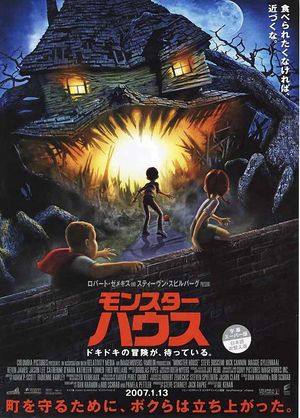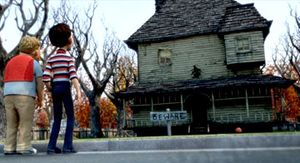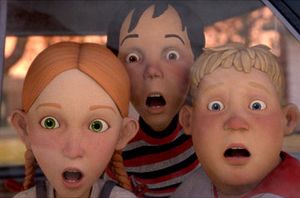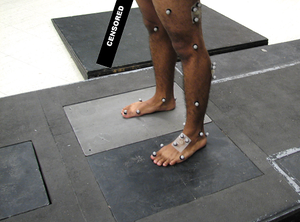Monster House (film)
Monster House is a 2006 computer animated horror/black comedy film about a murderous living house and the misadventures of three preteens who try to stop it. The film, produced by both Steven Spielberg and Robert Zemeckis, is known for its graphic nature, extensive drug use and sharp, satirrical black comedy streak. It has also become known as the first ever R-rated film made with motion capture technology, a new process itself at the time.
Plot[edit | edit source]
Warning: The following text might contain spoilers. This makes the article more aerodynamic, and thus more maneuverable at high speeds. Take caution and carry a first-aid kit at all times if you don't know that Titus Andronicus bakes Tamora's sons in a pie and feeds them to her, Bruce Willis is a ghost, the Magratheans rebuild Earth after the Vogons destroy it, the book "The Number 23" is actually about Jim Carrey's character's past, Sam Westing is still alive, disguised as Sandy McSouthers, and Soylent Green is PEOPLE!!! |
Lovable 12 year old "DJ" Walters (who is not actually a DJ) lives on the same street as 'Nam veteran William J. Nebbercracker. Nebbercracker is, however, a very sour person and takes away any sort of toy that ends up in his yard. Nebbercracker's house also seems weird - it has been known to, umm, eat children. But this doesn't put DJ and his obese friend Chowder off from bouncing their basketball into Nebbercracker's yard. As usual, Nebbercracker takes the basketball away, but at this point DJ utters the film's most famous line[1] and rugby-tackles Nebbercracker to the ground. The old man has a massive heart attack and dies is sent to hospital.
DJ's parents leave to go to Comic-Con, putting him in the care of dreadlocked suicidal emo babysitter Zee, who invites over her abusive boyfriend Boner. That night, DJ receives calls from Nebbercracker's house and Boner gets eaten by the house whilst trying to recover his very first condom. The next morning (which happens to be Halloween), Zee is woken up by a schoolgirl named Jenny attempting to sell heroin-laced candy so that people can be "ready" for trick-or-treaters. Zee tells her to fuck off but ends up buying two boxes of so-called crack cookies, which she gives to DJ and Chowder, who have been
watching the house from DJ's room. DJ sees Jenny approach Nebbercracker's house with her candy wagon and tells her to go back, but she calls him retarded and moves on. When the house tries to eat Jenny, DJ saves her, and Jenny takes over as the film's main love interest.
The trio of preeteens find Reginald "Skull" Skulinski, a hyper-depressive, obsessive-compulsive schizophrenic nerd who is obsessed with killing video game monsters and once played Mortal Kombat for two months straight whilst surviving on just a Subway sandwich and a diaper. Skull tells them that the house is a dongus magtabily, which is Latin for human house. DJ assumes that this means that Nebbercracker's soul is in the house, and that they have to put out the fireplace to kill the house as it has been burning ever since Nebbercracker had the heart attack. Chowder then suggests to fill a dummy with the heroin cookies from earlier in the film and feed it to the house, which should hopefully knock it out cold. However, this plan goes horribly wrong when two inept cops catch the kids in the act and lock them in the car. Suddenly, the house eats both the cops and the car. The kids manage to escape from the car before they are crushed to death, but are still trapped in the house.
The house falls asleep, leaving DJ, Jenny and Chowder to roam around. They see that Nebbercracker used to be a member of the Demolition Squad, and used to have an obese wife named Constance. Then the trio go into the basement, where Chowder urinates on Jenny. Then DJ finds a large metal cage and inside is Constance's dead body, encased in cement. Suddenly, the house wakes up and anally violates Chowder with killer slinkies. Jenny is sucked up by huge pipes. DJ manages to walk up the stairs, but then realises that he, Jenny and Chowder are how standing right over the house's teeth. Luckily, Jenny still has one of the heroin cookies with her and she drops it down the house's throat. The house vomits the trio onto the lawn, where Nebbercracker is waiting.
Nebbercracker explains that his wife Constance used to be the world's obese-est woman until a teenager pushed her down a cement-filled well. Then, the house rips out of its foundations and chases DJ, Chowder, Jenny and Nebbercracker into an abandoned or possibly haunted building site where Nebbercracker blows the house up. The final scene shows Nebbercracker and DJ handing back all the things Nebbercracker took over the years. They find Boner's first condom and laugh. Suddenly, DJ wakes up, and it is revealed that the majority of the film is a hallucination that DJ has exerienced due to the crack cookies.
Development[edit | edit source]
Origins[edit | edit source]
Monster House actually started off in 2004, as the first draft of a thrilling political novel written by Tony Blair. But with a little Hollywood magic, Sony had aquired the rights to the film. Meanwhile, Robert Zemickis was looking for an excuse to work with Steven Spielberg again (the last time they had been together was on the set of BTTF III). He was then asked to make some money out of the Monster House concept. Zemickis showed the idea to Spielberg and they began to write the script together.
The first draft was aimed at kids (it can be found here). In this version, the house is a carebear and DJ is a real DJ. Spielberg and Zemickis then figured that this draft was pretty dark for the intended PG rating, so they started again, from scratch. The next draft was a crude bloodbath. The wit and satire of the finished product existed in this version as toilet humour and gore. Reminding themselves of their high status in terms of directing, the pair decided to stay closer to the source material and once again began to rewrite the script. However, it had to be put aside as both Spielberg and Zemickis has other projects to concentrate on. Eventually they just hired a professional screenwriter to do it, and finally managed to start on filming in early 2005.
Motion Capture[edit | edit source]
Motion capture, or Motiviphluric Phyllosenvitic Collestaphysio in its full form, is a long and time wasting process that is used to make more expensive animated films. Some peole say it has good points, such as rapid, almost real time animation and effectiveness, but they are weighed down by many cons, such as extreme pain if one of the actors gets an erection, the $8 million "motion capture tax" and, of course, the fact that Disney hated motion capture's guts. Motion capture is typically seen in video games and Coke commercials, but Zemickis was Convinced that "mocap", as the hip people call it, was the right way to go. In fact, Zemickis had already used it in his previous film, the Bipolar Express.
Spielberg as well as the studio were unsure about using motion capture for an adult film (as previously stated, it would be the first). In fact, an entire advertising campaign was launched in mid-2005 that advertised the film as 100% mocap-free. This blew $20 milliom of the $113 million budget. Remickis threatened to leave the project when he discovered the campaign, and this led to a slap fight between Spielberg and Zemickis (this video was leaked on the internet a week later but soon Spielberg's lawyers threatened to sue the uploader, and the video was then removed). Ultimately, it was Sony's offer of infinite money and hookers that convinced the two to calm down and stop making a scene. Later that day, Zemickis forced Spielberg to move the film over to mocap in a game of poker.
Interpretations[edit | edit source]
"Suburbian insanity" theory[edit | edit source]
In 2007, an internet blogger jokingly posted that the house in Monster House symbolises the ultimate flaw in an otherwise ideal suburbian area; that the kids symbolise those who have become painfully used to complete perfection, and will stop at nothing to remove this sore thumb, if you will, from their neighbourhood, and the whole movie is a surreal demonstration of these points. Many people understood this as what it was - a joke - and spread the word of this, but soon a few artsy-fartsy types stumbled across this joke and began to question its reality. Several critics began to balance their reviews on this theory, and Steven Spielberg himself reportedly made an annonymous account on a forum discussing this and posted that it was utter bullshit.
"Growing up" theory[edit | edit source]
Another theory is that the entire film is a surreal look into the trials of growing up, particularly DJ's transition from a boy to a teenager. Whilst somewhat disturbing and also the proof that 'Spielberg is a paedophile' theorists need, this theory is fairly plausible in terms of being on-par with the film.
"Don't do drugs" theory[edit | edit source]
It is thought by some that Monster House is actually a big Don't Do Drugs message. This can be seen in the twist ending, where the severeness of heroin-induced hallucinations comes into play, and when Jenny uses the coke cookies to make the house vomit. However, anti-drugs campaigners have criticized this, saying that the film nevertheless "encourages drugs" and "isn't negative enough". The creators retorted with the following message: "Shut the fuck up."
Critical reception[edit | edit source]
Monster House has received overwhelmingly positive reviews. Critics praise its satirical edge[2] and enjoy its dark humour [3]. The film has a 74% approval rating on Rotten Tomatoes.
References[edit | edit source]
- ↑ By which I mean "Enough is enough! I have had it with these motherfucking old people on this motherfucking street!"
- ↑ http://www.colesmithey.com/capsules/2006/07/monster_house.htm
- ↑ http://homepages.sover.net/~ozus/monsterhouse.htm



